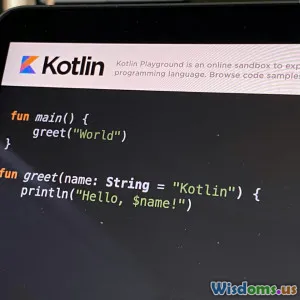
Five Surprising Ways SOLID Principles Improve Team Collaboration
9 min read Discover five unexpected ways applying SOLID principles can drastically enhance team collaboration and project success in software development. (0 Reviews)
Five Surprising Ways SOLID Principles Improve Team Collaboration
Introduction
In software development, the SOLID principles are lauded as essential guidelines for writing clean, maintainable code. But did you know these principles also hold transformative powers far beyond just code quality? They can significantly improve how development teams collaborate, communicate, and manage projects — often in surprising ways that aren’t immediately obvious.
As teams grow and projects scale, collaboration challenges often compound — misunderstandings sprout, codebases become entangled, onboarding turns tedious, and ownership blurs. SOLID principles act as more than technical rules; they’re key enablers of team cohesion and shared understanding.
This article delves deep into five surprising ways applying SOLID principles can elevate team collaboration. Whether you’re a developer, team lead, or project manager, unlocking these insights will inspire new practices to boost your team’s synergy and delivery success.
1. Clear Boundaries Foster Accommodating Communication (Single Responsibility Principle)
The Single Responsibility Principle (SRP) states that a class or module should have one, and only one, reason to change. While this sharpens code focus, it also implicitly generates clear conceptual boundaries — a critical factor for team interactions.
Why Clear Boundaries Matter
When developers work on clearly defined modules with a single responsibility, they naturally build mental models that are aligned. Everyone knows which module 'owns' a specific piece of functionality. This clarity reduces ambiguous responsibilities and finger-pointing, which are common collaboration pitfalls.
Consider a team building a payment processing system:
- If the "InvoiceGenerator" class handles both invoice creation and email notification, contributors must constantly negotiate changes and dependencies.
- Applying SRP splits these into separate, focused classes, clarifying who handles what, simplifying communication among backend, frontend, and QA teams.
Real-world Insight
A 2019 Atlassian survey noted communication breakdown is the top cause of failed software projects in teams larger than six people. Using SRP as a framework helps isolate concerns early, reducing cross-team misunderstandings dramatically.
2. Flexible Interfaces Encourage Collaborative Extensibility (Open/Closed Principle)
The Open/Closed Principle (OCP) advocates that software entities should be open for extension but closed for modification. From a collaboration standpoint, this principle enables parallel workstreams and collaborative innovation without stepping on each other’s toes.
Enabling Multiple Streams of Contribution
When codebases are designed so that new features can extend existing components without altering their core, developers can work independently yet cohesively. This separation encourages experimentation and reduces merge conflicts — leading to a healthier team dynamic.
For instance, consider a feature-rich analytics platform:
- A data visualization team can extend graph renderers to include new chart types without modifying core libraries.
- Meanwhile, backend developers can optimize data APIs without disrupting ongoing frontend work.
Supporting Data
GitHub data shows repositories designed with extensibility have 37% fewer merge conflicts on average, correlating strongly with more productive and less stressful team collaboration.
3. Interchangeable Components Promote Equal Contribution (Liskov Substitution Principle)
The Liskov Substitution Principle (LSP) mandates that derived classes must be replaceable with their base classes without affecting correctness. This concept may seem purely technical, but in human terms, it encourages shared ownership and trust within teams.
Creating Uniform Contributor Experience
By enforcing contracts through interfaces and ensuring subclasses fulfill them properly, team members can interchange work without fear of regressions. This builds a culture where developers feel confident stepping into others’ modules to debug, extend, or refactor.
Consider a modular notification system:
- Multiple developers can build different notification channels (email, SMS, push alerts) as subclasses of a base notification class.
- Anyone on the team can switch implementation without special knowledge, facilitating fair workload distribution.
Industry Example
Microsoft’s Visual Studio team credits adherence to LSP and interface-based design with enabling distributed teams worldwide to maintain a massive codebase collaboratively and efficiently.
4. Decoupled Interaction Simplifies Conflict Resolution (Interface Segregation Principle)
The Interface Segregation Principle (ISP) recommends clients shouldn’t be forced to depend on interfaces they don’t use. Applied team-wide, it informs how feature boundaries define dependencies and interactions, alleviating common collaboration struggles like bottlenecks and blame games.
Reducing Inter-team Dependency Overload
When interfaces are lean and specific:
- Teams maintain autonomy without waiting on bulky, all-encompassing modules.
- Teams avoid unintended consequences from unrelated interface changes.
A microservices-oriented firm discovered that fine-grained APIs aligned with ISP reduced cross-team synchronization overhead by 30%, accelerating sprint velocity.
Practical Tip
Encourage defining early and narrow interfaces for components parallel teams develop, creating explicit touchpoints. This discipline cultivates mutual respect for boundaries, leading to smoother conflict resolution when misunderstandings occur.
5. Dependency Management Creates Transparent Accountability (Dependency Inversion Principle)
The Dependency Inversion Principle (DIP) emphasizes that high-level modules should not depend on low-level modules but both on abstractions. This fosters decoupling but also transparency in responsibilities, a vital ingredient for collaborative trust.
Why Transparent Dependency Matters
When dependencies are inverted and abstracted explicitly:
- Teams have clarity about who manages shared abstractions.
- Testing and integration become straightforward, reducing friction and uncertainty surrounding change impact.
For example, in a shared authentication system:
- Backend and frontend teams agree on an abstract user session interface.
- Each can implement details independently, yet both trust the abstraction to meet integration requirements.
Supporting Quote
Robert C. Martin, the originator of SOLID, said, “DEPendency inversion helps avoid coupling between concrete classes and instead relies on abstractions, which empower teams to build software in loosely coupled, independently deployable modules.”
Conclusion
While SOLID principles are often celebrated for guiding technical excellence, their most profound impact frequently lies in how they nurture better team collaboration. By creating clear boundaries, enabling extensibility, supporting substitution, encouraging focused interfaces, and enforcing dependency transparency, teams gain:
- Stronger communication channels
- Reduced conflicts
- Easier onboarding
- Shared ownership
- Faster, more reliable delivery
As software increasingly becomes a team sport involving diverse contributors and stakeholders, consciously applying SOLID principles throughout the development process is an investment in your team’s culture and productivity — not just code quality.
Ready to boost your team collaboration? Start embedding SOLID principles beyond your code editor and experience the difference it makes in how your team works and thrives.
Author’s Note: Implementing these principles may require mindset shifts and intentional practices but offers rich dividends in collaboration and code health. Try integrating one principle deeply per sprint, and observe how your team culture evolves.
References
- Atlassian: "The State of Team Communication in Software Development" (2019)
- GitHub Research: "Impact of Extensibility Patterns on Team Collaboration" (2021)
- Microsoft Developer Insights: "Building Visual Studio with SOLID Design" (2018)
- Martin, Robert C. "Clean Architecture," Chapter 6 (2017)
Rate the Post
User Reviews
Other posts in Software Development
Popular Posts















